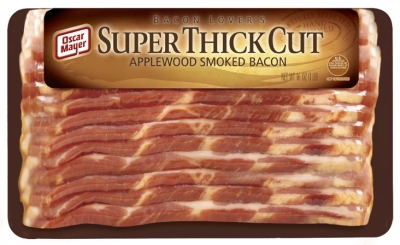This is one of those “random thoughts” posts…no professorial musings, plant geek gushings, or interpretations of useful research. And absolutely, positively, in no way, expressed or implied, intended to provoke a veg/carnivore controversy nor promote any particular product.
Just a simple question that occurred to me in the grocery store.
“WHERE is all this apple wood coming from?”

Google “apple wood smoked bacon” and get 689,000 results. Apple wood also frequently appears as “applewood”, orthographical conventions aside. We’ll just refer to it as AWSB for the duration of this post. Wendy’s is promoting their burger with AWSB all over the place. Kraft’s Oscar Mayer division recently released a new AWSB product nation-wide (according to the blog www.mrbaconpants.com) What used to be available only through specialty meat companies and at high-end grocery stores is now available everywhere.
Back to my question. That’s a lot of bacon to smoke.
Apples used to be an important part of the mid-Atlantic and Northeastern commodity mix. Arkansas had its own “Apple Belt”. These markets have experienced a fairly dramatic decline; much of U.S. production has shifted to Washington state. So are some of these out-of-production orchards the source of all this wood?
I may ask this question of some apple experts I know. Linda, I bet you’re up to your pits in pomologists at Washington State – see what they say (and I apologize in advance for the looks you’re going to get). Also – how much apple wood has to be used in the process to officially, legally, be considered AWSB? May have to pester a food scientist.
All I can think of is they’re taking advantage of farmer’s yarding out “old” apple varieties to replace them with whatever’s popular. I remember Eastern Washington when the Fuji apple really hit the market–suddenly there were piles and piles of various apple tree varieties that had been ‘dozed up and shoved aside to make room to plant yet more Fujis.
Don’t pester a food scientist. Pester a marketing specialist. I always thought that apple wood (or applewood) smoked anything was about the same as Corinthian leather.
As an avid smoker, I can tell you apple wood is good for pork, especially tenderloins. I’ll also throw in a few clumps of apple wood when doing ribs, but mostly stick with hickory which may be soaked in apple juice. That said, I don’t get a lot of the apple wood flavor off of all these packaged foods. It could really be a use for old apple trees.
Thanks all. Bryn, your comments reflect an opposite problem here in Virgnia – many growers didn’t want to replant with newer varieties in demand for fresh use; thus ended up in the less-profitable processed/juice market. And Elizabeth…you raise a good point – is there a real difference or is just a perceived one (sing it with me: “Volaaaare…whoaa oh…”). CP – you’re just making me hungry.
I would read the label before I believed it was actually smoked with burning apple/wood from trees as opposed to an apple-wood smoke flavoring.
Digging a little deeper here, anyone who eats pork is going to lose energy. Who in their right mind would want to make themselves ill by consuming pork (bacon, ham, sausge, pepperoni, anything made from pork including pork grease they pour over food at many resturaunts so the food ‘tastes’ good.
Seriously – a blog called mrbaconpants? You know that’s going to sabotage my plans for getting work done this afternoon.
Hi Folks, the tree fruit nerd checking in here—apple orchards are in constant need of renewal pruning, tree removal and general renovation. Apples are excellent biomass producers. As a result any apple-producing areas in the US are usually awash in a sea of apple wood trimmings, easily obtainable usually for the asking and self hauling. FDA guidelines for smoked/cured meat products are more concerned with nitrate levels, and smoking is “GRAS-generally regarded as safe”. I quote: “Smoke may be produced by burning wood chips or using an approved liquid smoke preparation. Liquid smoke preparations may also be substituted for smoke by addition directly onto the product during formulation in lieu of using a smokehouse or another type of smoking vessel.” Fake(liquid) smoke ingredients have to be listed.
Full disclaimer: I’m a WSU professor that has been studying apples for a long, long time.
Mmmmm…liquid smoke. I actually have a bottle of this stuff (I made beef jerky from scratch at one point in my life). I really can’t believe that liquid smoke is GRAS. I always thought it more of the “cancer in a bottle” flavoring.
Howdy Dr. John! Thank you so much for your insight and answers to my burning [smoking] questions!
So there you have it.
And Paul, I know you went straight to mrbaconpants.com.